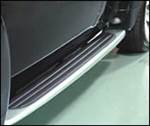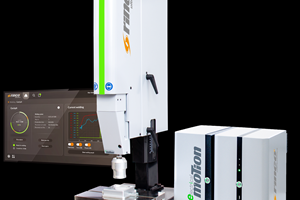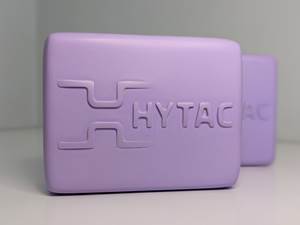New Polymer Uses Sunlight To Arm Itself Against UVDamage
Using sunlight to protect against sunlight—that’s the unusual concept behind GE Plastics’ new Lexan SLX polymer.
Using sunlight to protect against sunlight—that’s the unusual concept behind GE Plastics’ new Lexan SLX polymer. This clear, high-gloss resin was commercialized for Class A auto body panels and other outdoor weatherable applications in 2001 under the name Sollx. Today it goes by the name Lexan SLX, and for the first time GE is publicly revealing details of its chemical composition and how this clear, colorless resin that contains no pigments or additives can provide a paint-free, decorative finish that lasts for 10 years.
Shape-shifting sunscreen
Until recently, GE said only that Lexan SLX is an amorphous polycarbonate copolymer. Now the company has revealed what kind of copolymer. As shown in Fig. 1, the resin consists of PC segments alternating with ITR segments. ITR (isophthalate terephthalate resorcinol) is the part that contributes the weathering protection—but not in its native state. When initially exposed to sunlight, Lexan SLX lets uv light pass through freely. But in its first day outdoors, the resin stores up enough solar energy to undergo a chemical transformation. The ITR segments rearrange themselves to form hydroxybenzophenones embedded in the polymer chain that absorb almost all uv and near-uv radiation (Fig. 2).
The reaction occurs only in the top surface of the polymer to a depth of a few microns. As the surface erodes very slowly over time, the next few microns will then go through the same photochemical reaction.
Ensemble act
In its most highly publicized uses so far, Lexan SLX has acted as one component of a decorative surfacing system that can replace paint. As shown in Fig. 3, Lexan SLX forms the clear, colorless surface layer of a coextruded film to be used as a preformed insert for in-mold decorating (IMD). Lexan SLX protects the underlayer of pigmented Lexan PC. The resulting film can then be laminated to a thicker substrate of PC, a PC alloy, or most polyesters. With the addition of an appropriate tie layer, the SLX film can adhere to glass-reinforced poly urethane, long-glass polypropylene composites, TPO, PP/PPO alloy (GE’s Noryl PPX), or even thermoset polyester SMC. The SLX film can withstand SMC molding temperatures, says Venkatakrishnan Umamaheswaran, GE’s industry manager for SLX body panels. He adds that it may even be possible to laminate SLX film to steel for stamping.
When exposed to more than 25,000 kJ/m2 of xenon-arc accelerated weathering—said to be equivalent to 10 years outdoors in Florida—SLX film retains 95% of its gloss. (Starting value for 60° gloss is >100.) When back-molded with GE’s Xenoy PC/PBT resin and subjected to OEM paint specification tests, SLX film reportedly performs in most cases better than or equal to exterior paint systems. Some of the more strikingly positive results are in resistance to scratches, brake fluid, and acid rain, GE reports. Lexan SLX also boasts good resistance to fuels. Though it has good surface hardness, scratches and gouges can be buffed out easily, GE claims.
Hitting the road
GE’s primary target for SLX film is automotive paint replacement in IMD applications, says Todd Sweeney, global market manager for Lexan SLX. Available in solid and metallic colors, it has already appeared in the roof panel of the Smart roadster, made in Germany. Front fascias, fenders, door panels, mirror housings, trunk lids, and a hood are also in development. Other possibilities are wheel covers and accent trim. Non-automotive applications include fenders on the Segway transporter. SLX film/sheet product manager Bob Johnson sees further potential in outdoor enclosures for communications equipment and parts for heavy trucks, lawn/garden equipment, construction, and boats.
If laminated to heavier sheet, SLX film can be directly thermoformed into finished parts. Lexan SLX is said to have greater than 200% draw capability. Promising markets are panels for off-road construction and recreational vehicles, lawn/garden equipment, and auto aftermarket parts. Clear sheet of SLX film laminated to PC could find a home in lighting, signs, displays, and industrial screens.
GE recently fielded an injection molding grade (Lexan SLX 2431) that can be used on its own to make large lenses for industrial and street lighting.
Related Content
Next-Generation Fully Electric Ultrasonic Welding System
NPE 2024: Rinco new eMotion servo-driven machine is available in 20 kHZ and 35 kHz frequencies.
Read MoreCan Plastic Recyclates be Welded Ultrasonically?
What is possible with ultrasound? Will the result with recycled plastics material actually be worse than with standard material? Do we have to adapt our technology?
Read MoreHigh-Temperature Syntactic Foam and High-Slip Plug Materials for Thermoforming
At K 2022, CMT Materials to launch new Hytac syntactic foam and a developmental higher slip plug materials with no PTFE.
Read MoreOMV Technologies Gets New CEO
Kooper brings 33 years of experience in the industrial and consumer packaging industries to OMV--the closed-loop, turnkey, inline extrusion, thermoforming and tooling systems manufacturer.
Read MoreRead Next
Thermoforming Goes Paint-Free, Too
Thermoformed parts play two roles in the expanding field of in-mold decorating (IMD) of plastic parts: For injection molding, IMD begins by thermoforming a thin film into decorative shells that are placed in the injection mold cavity and then back-molded with a compatible substrate.
Read MoreWhere the Action Is: Decorating with Formable Films
Plastics processors are eyeing form able films as an economical, durable, and environmentally friendly means of producing fully decorated parts right out of the mold.
Read MoreUnderstanding Melting in Single-Screw Extruders
You can better visualize the melting process by “flipping” the observation point so that the barrel appears to be turning clockwise around a stationary screw.
Read More


























